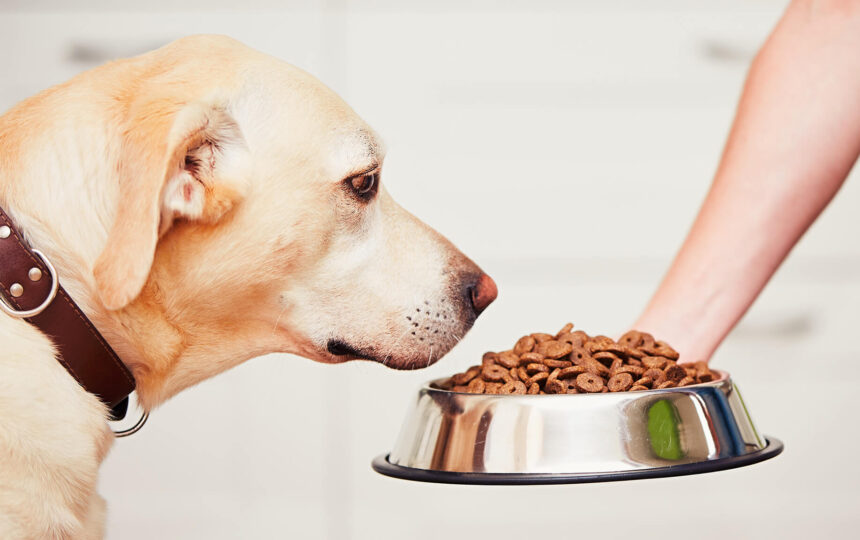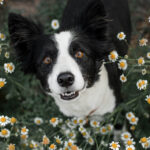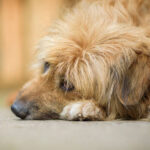Shopping for dog food can be an intense, intimidating, and overwhelming experience. Shelves are bursting with options, all claiming to be the best on the market and offering many health benefits. Fancy packages with false health claims add to the confusion. Pretty pictures of fresh food form a deceiving picture in our minds.
We might choose the cheapest option, thinking it seems ok and fits our budget. This choice is often kibble or dry dog food. We can buy it in a big bag, it stores well and is easy to feed with no extra time needed or mess to clean up.
Sadly, kibble – even those brands claiming to be healthy – is one of the worst types of dog food on the market – although the manufacturers will have you believe differently – and can lead to devastating health problems brought about by chronic inflammation.
There is no mistaking that inflammatory conditions, including allergies, obesity, and cancer, are prevalent in our furry friends. What we feed our pets has a significant bearing on their health.
In this article, we will unpack the dark side of kibble and present a superior alternative that will keep your best friend healthy and happy.
What is kibble?
The term “kibble” refers to any dry dog food that is heavily processed.
The basic ingredients in most kibble formulations are grains, fillers, vegetables, and meats. These are mixed, ground into flour, baked using an extrusion process, and dried. Once the pellets have cooled, many manufacturers spray them with synthetic fats to make them more desirable to dogs.
Convincing reasons to quit kibble
If kibble is your “go-to” feed, here are some compelling reasons to consider switching to something else.
Carbohydrates, fillers, and synthetic ingredients
Have you ever checked out the ingredients on a bag of kibble? Sure, you may see things you recognize, but how much do you not recognize? How many words can you not even pronounce? Usually, the words are so small that most people need a magnifying glass to read them.
You will most likely see the amount of protein on the food label but nothing about the carbohydrates. Dog food manufacturing companies don’t want consumers to know just how much carbohydrates are in the food because it is high. It is so high that it promotes obesity – especially in inactive dogs.
The high amounts of carbohydrates, sugars, fillers, and synthetic ingredients such as dyes and fragrances found in kibble can cause allergic reactions and strain the digestive tract, leading to gastrointestinal issues, including leaky gut.
Leaky gut, also known as increased intestinal permeability, is a condition in which the small intestine’s lining becomes damaged. This can lead to undigested food particles and toxins passing through the intestinal wall, causing inflammation and impacting the health of other organs.
High heat processing leads to the formation of carcinogens.
Kibble is ultra, ultra-processed. Cooking the ingredients at extremely high heat – over 400 degrees F, increases the pro-inflammatory properties in the food and destroys most of the nutritional value present in the first place while stripping away beneficial bacteria and moisture.
Furthermore, thigh heat processing of meat, poultry, and fish often causes carcinogens like heterocyclic amines to form. These are linked to mutations in animal cells and also cancer. One study that looked at 25 types of commercial dog food found heterocyclic amines in 13 of them.
Another potential carcinogen, acrylamide, found in kibble occurs when sugars and amino acids reach very high temperatures. Because of the extrusion process used to create kibble – this potential carcinogen is always a threat.
Researchers have also uncovered another dangerous substance in highly processed dog food, polybrominated diphenyl ethers( PBDEs). This substance, used as a flame retardant in furniture and electronic equipment, has been
linked with a range of health problems, including thyroid disruption, liver damage, memory loss, and behavioral changes.
Dangerous preservatives
It is difficult to find the origin of most kibble food. Often it is shipped from production facilities – sometimes in China and other countries overseas. Manufacturers add dangerous chemicals and preservatives to dog food to keep it stable for the journey and the store shelf. Remember that these preservatives and chemicals are not necessarily safe for human consumption. This means they are not safe for your pet either. They are pro-inflammatory and even toxic.
Ethoxyquin, banned by the European Union and not permitted in Australian-made dog food, is an artificial preservative found in some brands of kibble that doubles as a pesticide and a hardening agent in making synthetic rubber. Under investigation by the FDA for causing liver and blood problems, this chemical is hazardous.
Other chemical preservatives in kibble include butylated hydroxyanisole (BHA) and butylated hydroxytoluene (BHT). According to the World Health Organization, both compounds are potentially carcinogenic. The State of California has also identified these as possible carcinogens.
Additional potentially toxic chemical preservatives in commercial dog food include:
- Propylene glycol – a synthetic food additive in the same chemical grouping as alcohol
- Propyl gallate – an artificial food additive also used in personal care products and pharmaceuticals
- TBHQ – food preservative with a controversial reputation
Kibble is not species-appropriate.
Dogs did not evolve on corn, wheat, synthetic fillers, dyes, and chemical preservatives. Like humans, they are not designed to eat and thrive on highly processed food. Kibble lacks key ingredients necessary for a long and healthy life and is loaded with those that promote obesity, inflammation, and sickness.
Switch to a raw diet and watch your pet thrive
Feeding yourself, your family, and your dog(s) a balanced and healthy diet promotes wellness. One of the best ways to love your dog is to switch to a raw diet, free of harmful chemicals and bursting with the natural building blocks that support health.
Dogs are technically classified as omnivores, but many will argue that they are scavenging carnivores. Although dogs can survive on plant material, they thrive on a diet made from minimally processed animal protein. This aligns with their carnivorous heritage and provides dogs the energy they need to live an active and healthy life.
Although raw dog food diets may vary slightly, they most support feeding the following:
- Muscle meat – may still be on the bone
- Bones – whole or ground
- Raw eggs
- Organ meats
- Vegetables including broccoli, spinach, and celery
- Apples or other fruit
- Minimal dairy – yogurt primarily
Benefits of going raw
Right out of the gate, it is clear to see that raw food is real food and real food is what both humans and dogs were designed to eat. Whole, unprocessed ingredients not exposed to high heat and chemicals fuel the body rather than bog it down.
A raw food diet is an excellent way to promote your dog’s instincts.
Like their wild ancestors, dogs are designed to eat a diet rich in raw meat, bones, organs, and some fruits and vegetables. This means they get all the essential vitamins, minerals, and amino acids needed for optimal health, along with enzymes crucial for healthy digestion and absorption of nutrients.
Because raw foods are more nutrient-dense than processed alternatives, dogs eat less but still get the same nutrition. This can help keep your pup at a healthy weight.
Raw diets contain fresh, natural ingredients that are more easily digested and less likely to create an allergic reaction in dogs than processed foods.
Eating raw food is much harder work for a dog’s teeth than crunching up kibble. This helps to keep the plaque and tartar away, reducing the risk of dental disease.
What will your pup’s next meal be?
As pet parents, we hold the key to our furry friend’s health and happiness. We can make choices that will promote health or promote sickness. Choosing a raw diet is one of the best decisions you can make for your pup’s health and well-being.
Going raw means you provide your pup with a tasty, balanced diet, including all the essential nutrients your pup needs for energy, growth, maintenance, and repair.






